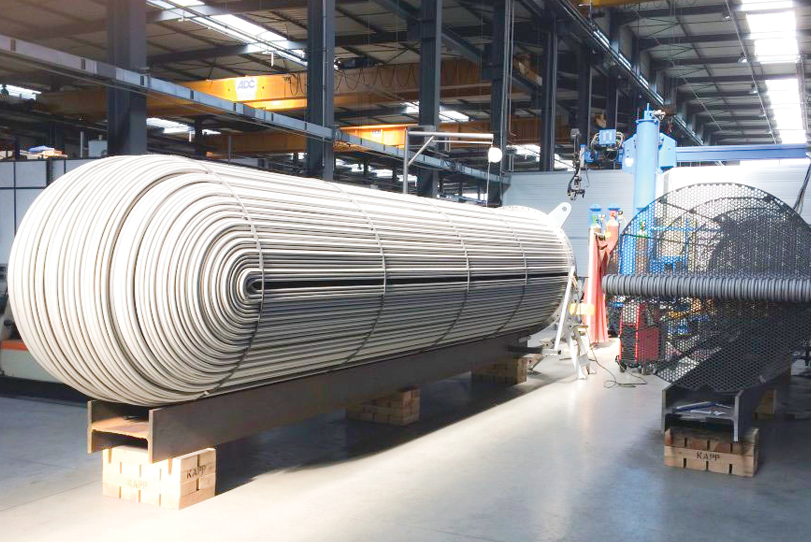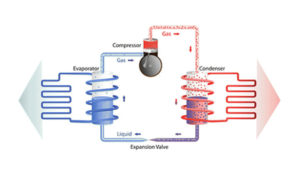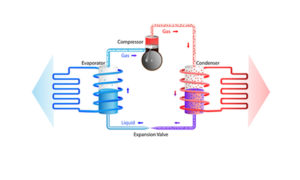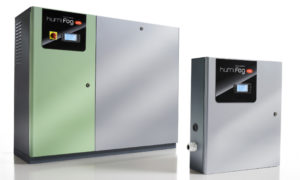Heat Exchanger is a device for an efficient heat transfer between two fluid media. The two medium may be in separate paths or be in direct contact. Heat Exchangers are mainly used in generators, compressors and process cooling like space heating, refrigeration, air conditioning, power plants and chemical plants, marine, automobile, petrochemical plants, petroleum refineries and natural gas processing, nuclear plants, ports, ship building centre, Indian railway etc. The heat exchangers flow in two natures. One is co current flow [Parallel Flow], second one is counter current flow [Counter Flow]. This Heat Exchangers are mainly used for reducing or increasing the heat in one media to another media.
How does a heat exchanger work?
- Heat exchangers are classified into two types, according to the arrangement of flow. The two types are basically the parallel flow and the counter flow exchangers. The parallel flow exchange involves the two mediums going into the exchanger through the same side of the device. The two fluids enter the heat exchanger from the same side and travel parallel to each other in the whole process.
- In the counter flow exchange, just the reverse happens. Here the fluids enter the device from the opposite ends and meet each other in the process of heat exchange. Most exchangers use this flow as it is proven to be more effective than the other process. This is due to the fact that it can transfer more heat from the heating medium to the other medium. In this kind of a setup, the mediums travel to one another and then the exchanger processes them.
- Conventionally, the exchangers are designed in a way that the surface area between the two exchanging fluids gets maximised in the process of minimising the resistance to the exchange flow at the same time. Extra fins are installed in both the directions so that the fluids can enter whilst enhancing the efficiency of the exchangers. These fins add to the surface area of the exchangers as well as help in controlling the flow of fluids during the process of exchange.
- Depending on the size of the exchanger, the temperature will vary during the process of exchange. The temperature also varies according to the position of the device. This temperature is calculated in terms of the Log Mean Temperature Difference or the LMTD. When it becomes difficult to determine the temperature with this method, the NTU method is the most preferred one.
Customer Commitment
Heat Exchangers is committed to its customer satisfaction through supplies of quality products with continual development and improvement its product processing system. It assures the quality of its each and every product. Heat Exchangers are carefully designed, analysed and tested with latest software from Thermal design, mechanical, selection of raw materials, witnessing of pressure testing as per specifications and the quality is tested with its own quality control departments. Outfitted with proficient engineers and employees and updated technology. Production stage is well planed and screened with production planning department. Products undergo various quality checks before leaving the company premises like metallurgy, X-Ray Hydraulic, Pneumatic, Penetration testing. Also third party inspection agency like DGQA, Lloyds Register, Bureau Veritas, IBR, RITES and Engineers India are also arranged for Quality assurance based on the customer needs.
Types of heat exchangers
- Shell and tube heat exchanger
- Plate heat exchanger
- Plate and shell heat exchanger
- Adiabatic wheel heat exchanger
- Plate fin heat exchanger
- Pillow plate heat exchanger
- Fluid heat exchangers
- Waste heat recovery units
- Dynamic scraped surface heat exchanger
- Phase-change heat exchangers
- HVAC air coils
Spiral heat exchangers
Benefits
- As already discussed, a heat exchanger is equipment that allows the efficient transfer of heat from one medium to another. They are used in air conditioning, refrigeration, sewage treatment, chemical plants and a lot more fields. It is a revolutionary device and lot of major companies are investing in this technology. It is not without any reason that heat exchangers are so popular.
- Adaptability: Other than energy efficiency, modern exchangers are also adaptable and versatile. They are not only portable but are also flexible.
- Temperature management: These devices can manage very close approach temperatures because of true counter flow and high temperature transfer efficiency.
- The heat exchangers can cover the largest of areas and are designed to produce a high turbulent flow and excellent distribution of temperature.
- The energy efficient heat exchangers can also be maintained very easily. They do not corrode very easily and have larger shelf lives.
The heat exchangers also have multiple uses starting from commercial applications to residential purposes.
Cookie Consent
We use cookies to personalize your experience. By continuing to visit this website you agree to our Terms & Conditions, Privacy Policy and Cookie Policy.















